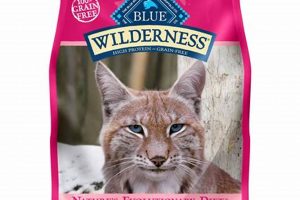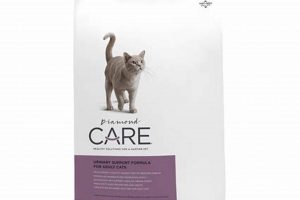A finely textured, whipped formulation designed for feline consumption is increasingly prevalent. This type of product typically presents a light, airy consistency, differentiating it from pate or gravy-based offerings. For example, manufacturers often utilize a higher moisture content and specialized processing techniques to achieve the characteristic delicate texture.
The appeal of this food option stems from several advantages. Its ease of consumption is particularly beneficial for kittens transitioning to solid food, senior felines with dental issues, or cats with diminished appetites. The increased palatability often encourages consumption, ensuring adequate nutrient intake. Historically, specialized textures were employed to address specific dietary needs; however, the enhanced palatability has broadened the product’s general appeal.
The subsequent sections will delve into the nutritional composition of this product, examine its suitability for various life stages and health conditions, and provide guidance on selecting and incorporating it into a cat’s diet. A comprehensive overview aims to equip readers with the knowledge necessary to make informed decisions regarding their feline companion’s nutritional well-being.
Tips for Selecting and Utilizing Mousse Cat Food
The following provides guidance on selecting and incorporating this type of cat food into a feline’s diet to optimize nutritional benefits and address specific needs.
Tip 1: Prioritize High-Quality Protein Sources: Examine the ingredient list to ensure that meat, poultry, or fish are listed as primary components. Adequate protein intake is crucial for maintaining muscle mass and overall health.
Tip 2: Evaluate the Moisture Content: This food type is typically high in moisture, contributing to hydration. Confirm that the formulation aligns with the cat’s specific hydration requirements, particularly if the cat has kidney issues.
Tip 3: Consider the Life Stage and Health Condition: Specific formulations exist for kittens, adult cats, and senior cats, as well as for cats with specific health conditions (e.g., sensitive stomachs). Choose a product that corresponds to the cat’s individual needs.
Tip 4: Introduce Gradually: When transitioning to a new food, introduce it slowly by mixing it with the existing food to minimize digestive upset. Observe the cat’s stool consistency and overall behavior during the transition.
Tip 5: Monitor Caloric Intake: While palatable, adhere to recommended feeding guidelines based on the cat’s weight, activity level, and overall health. Overfeeding can lead to weight gain and associated health problems.
Tip 6: Assess the Ingredient List for Allergens or Sensitivities: If the cat has known allergies or sensitivities, carefully review the ingredient list for potential triggers (e.g., grains, specific proteins). Consult with a veterinarian if necessary.
Tip 7: Observe Palatability and Acceptance: Not all cats will readily accept every food type. Observe the cat’s initial reaction to the food and adjust the flavor or brand if necessary to ensure adequate food intake.
Adhering to these tips allows for the selection of nutritionally appropriate formulations that support the feline’s health and well-being. Gradual introduction and careful monitoring are crucial for a seamless transition and optimal dietary outcomes.
The subsequent section will explore potential challenges and offer troubleshooting strategies associated with feeding cats this particular food type.
1. Texture and Palatability
Texture and palatability represent critical factors influencing a feline’s acceptance and consumption of food. Mousse formulations leverage these characteristics to enhance a cat’s dietary experience, especially where pre-existing conditions or preferences may limit intake of other food types.
- Sensory Appeal
The fine, whipped texture of this type of product presents a unique sensory experience distinct from coarser or denser formulations. This texture can be particularly appealing to cats that prefer a softer consistency or have difficulty managing solid foods. The olfactory experience is also significant; manufacturers often incorporate appealing aromas to further enhance palatability.
- Ease of Prehension and Mastication
The smooth consistency facilitates easier prehension, particularly for cats with dental problems or anatomical limitations. Mastication is minimized, making it easier for the cat to consume and digest the food. This is advantageous for senior cats or those recovering from oral surgery.
- Enhanced Digestibility
The emulsified state of a mousse formulation can promote improved digestibility. The processing techniques used to create this texture often break down complex proteins and carbohydrates, making them more readily accessible to digestive enzymes. This can be particularly beneficial for cats with sensitive stomachs or malabsorption issues.
- Flavor Delivery
The texture allows for even distribution of flavor compounds throughout the product. This ensures a consistent taste experience for the cat, increasing the likelihood of acceptance. The smooth texture also coats the palate more effectively, enhancing the perception of flavors and aromas.
The multifaceted relationship between texture and palatability underlies the success of this food option. The fine, whipped texture enhances sensory appeal, eases consumption, and promotes digestibility, while optimizing flavor delivery. These characteristics contribute to increased acceptance and ensure adequate nutrient intake, particularly for cats with specific dietary needs or preferences.
2. Hydration Benefits
Adequate hydration is crucial for maintaining optimal feline health, influencing kidney function, digestion, and overall well-being. Mousse formulations for felines can play a significant role in promoting hydration, particularly for cats that may not consume sufficient water through other sources.
- High Moisture Content
This cat food type characteristically possesses a high moisture content, typically ranging from 70% to 80%. This inherent moisture contributes directly to a cat’s daily fluid intake. For example, a cat consuming a significant portion of its diet as this type of product receives a substantial amount of water concurrently. This contrasts with dry kibble, which has a significantly lower moisture percentage.
- Support for Kidney Health
Felines are prone to kidney disease, and adequate hydration is vital for maintaining renal function. The increased water intake associated with this product supports kidney filtration and reduces the risk of urinary crystal formation. An example of this is the prescription of wet foods, including mousse varieties, to cats with diagnosed kidney issues to promote urine dilution.
- Improved Digestion
Proper hydration facilitates efficient digestion and nutrient absorption. Moisture aids in the breakdown of food and promotes regular bowel movements. Insufficient hydration can lead to constipation and other digestive complications. The moisture-rich nature of mousse formulations helps prevent these issues.
- Enhanced Palatability and Water Intake
The palatable nature of this type of product can encourage cats to consume more water indirectly. When a cat readily consumes its food, it may also be more inclined to drink water, further boosting its hydration levels. This is especially useful for cats that are naturally hesitant to drink from a water bowl.
The high moisture content, support for kidney health, improved digestion, and indirect promotion of water intake collectively highlight the hydration benefits of this type of feline food. These factors underscore its potential as a valuable component of a cat’s diet, particularly for those requiring increased hydration due to age, health conditions, or dietary preferences.
3. Ease of Consumption
The ease with which a cat can consume its food is a significant factor influencing its overall nutritional intake. Mousse formulations directly address this concern by offering a texture that requires minimal chewing and is readily digestible. This is particularly crucial for felines experiencing dental issues, such as missing teeth, gum disease, or post-operative discomfort. The soft, almost liquid consistency eliminates the need for vigorous mastication, reducing pain and encouraging consumption. For example, a senior cat with arthritis in its jaw may find it difficult to manage dry kibble but can easily consume this type of product without discomfort, ensuring adequate caloric intake.
The consistency also aids in prehension; the cat can easily lap up the food without needing to grip or manipulate it in its mouth. This is particularly advantageous for cats with facial injuries or neurological conditions that impair their ability to eat normally. A cat recovering from oral surgery, for instance, might be unable to tolerate solid foods, but a this food type provides a palatable and easily manageable source of nutrition. The reduced effort required for consumption also conserves energy, which can be beneficial for cats recovering from illness or surgery.
In summary, the enhanced “Ease of Consumption” represents a key attribute. It directly addresses challenges faced by cats with dental issues, physical impairments, or recovery needs, ensuring adequate nutrient intake, promoting healing, and improving overall quality of life. The understanding that texture and palatability directly impact a cat’s willingness and ability to eat allows for targeted dietary interventions, leading to improved health outcomes.
4. Nutritional Density
Nutritional density, the concentration of essential nutrients relative to caloric content, is a critical consideration when evaluating feline diets. While texture and palatability are important, a food source must also deliver adequate levels of vitamins, minerals, protein, and fats to support a cat’s overall health and well-being. Mousse formulations, despite their light and airy consistency, can be designed to provide a nutritionally complete and balanced diet.
- Macronutrient Concentration
Mousse formulations can effectively deliver high concentrations of protein, essential for muscle maintenance and repair in felines. Manufacturers often utilize concentrated protein sources to compensate for the increased moisture content. Similarly, fat content, crucial for energy and essential fatty acid provision, can be carefully controlled to meet the cat’s specific needs. The ratio of protein, fat, and carbohydrates must be carefully balanced to optimize metabolic health. For instance, a mousse product designed for kittens would necessitate a higher protein and fat concentration than one formulated for senior cats with reduced energy requirements.
- Micronutrient Fortification
Micronutrients, including vitamins and minerals, play vital roles in various physiological processes. Mousse formulations are frequently fortified with these essential compounds to ensure adequate intake. Examples include taurine, crucial for vision and heart health, and vitamin D, important for calcium absorption and bone health. The specific micronutrient profile should align with the cat’s life stage, activity level, and any underlying health conditions. Deficiencies in these micronutrients can lead to serious health complications, underscoring the importance of proper fortification.
- Bioavailability of Nutrients
The bioavailability of nutrients, or the extent to which they are absorbed and utilized by the body, is another critical aspect of nutritional density. The processing methods used to create these products can impact nutrient bioavailability. In some cases, the emulsification process may enhance the absorption of certain nutrients. However, excessive heat treatment can degrade heat-sensitive vitamins. Therefore, careful control of processing parameters is essential to preserve nutrient integrity and maximize bioavailability.
- Caloric Considerations
While these formulations can be nutritionally dense, it’s essential to consider caloric content to prevent overfeeding and obesity. The high moisture content can contribute to a feeling of satiety, potentially reducing overall caloric intake. However, it’s crucial to adhere to recommended feeding guidelines based on the cat’s weight and activity level. Monitoring body condition score is essential to ensure that the cat is maintaining a healthy weight. Failure to do so can lead to health problems associated with obesity, such as diabetes and joint problems.
The nutritional density of mousse formulations is a multifaceted consideration encompassing macronutrient and micronutrient content, bioavailability, and caloric control. When selecting this product, careful attention must be paid to the ingredient list, guaranteed analysis, and feeding guidelines to ensure that the cat’s nutritional needs are adequately met. Formulations designed for specific life stages or health conditions should be prioritized to optimize feline health and well-being.
5. Life Stage Suitability
Life stage suitability represents a cornerstone of feline nutrition, dictating dietary requirements that fluctuate across the lifespan. Mousse formulations, with their adaptable texture and nutrient profiles, present a versatile option that can be tailored to meet the distinct needs of cats from kittenhood to advanced age.
- Kitten Growth and Development
During the rapid growth phase, kittens require diets rich in protein and essential fatty acids to support tissue development and energy demands. Mousse formulations designed for kittens often feature finely ground ingredients and enhanced levels of these critical nutrients, facilitating easy consumption and optimal growth. Example: These formulations aid kittens transitioning from milk to solid food due to the texture.
- Adult Maintenance
Adult cats require a balanced diet to maintain lean muscle mass and support overall health. The protein and fat content can be adjusted in the mousse to provide adequate energy and nutrient requirements for adult cats with a higher activity level, promoting an healthy metabolism. Formulations designated for adult cats typically prioritize lean protein sources and moderate fat levels to prevent weight gain.
- Senior Cat Needs
Senior cats often experience dental issues, decreased appetite, and reduced digestive efficiency. Mousse formulations are particularly beneficial for older cats. They address the physical issues of the senior animal, which allows greater nutrient uptake as compared to foods that must be chewed. These formulations are often softer and more palatable, encouraging consumption despite reduced appetite, while also supporting kidney function through increased moisture content.
- Special Dietary Requirements
Cats with specific health conditions, such as kidney disease or diabetes, may require specialized diets. Mousse formulations can be adapted to meet these unique needs by adjusting the protein, phosphorus, or carbohydrate levels. Example: Renal support mousse formulations are commonly used in cats with kidney disease to manage phosphorus intake and promote hydration. In these cases, ingredients might be altered to provide greater nutrition as compared to foods that might not be accepted.
The adaptability of mousse cat food to meet the unique nutritional requirements of each life stage underscores its potential as a versatile dietary option for felines. By tailoring the texture and nutrient composition, manufacturers can create formulations that support optimal health and well-being throughout a cat’s life.
Frequently Asked Questions Regarding Mousse Cat Food
The following addresses common inquiries concerning this product, providing clarity on its suitability and benefits within a feline diet.
Question 1: Is mousse cat food nutritionally complete?
Formulations can be nutritionally complete, provided they are specifically designed to meet the AAFCO (Association of American Feed Control Officials) nutrient profiles for the cat’s life stage. Checking the product label for an AAFCO statement is crucial to ensure nutritional adequacy.
Question 2: Is mousse cat food suitable for all cat breeds?
It is generally appropriate for all breeds. However, individual dietary needs may vary based on factors like activity level, genetics, and pre-existing health conditions. Consulting a veterinarian for personalized recommendations is always advisable.
Question 3: Can mousse cat food contribute to dental problems?
By itself, it is unlikely to cause dental problems due to its soft texture. However, it does not provide the abrasive action of dry kibble, which can help remove plaque. Integrating dental chews or considering a mixed feeding approach may be beneficial for maintaining oral hygiene.
Question 4: How should mousse cat food be stored after opening?
Once opened, it should be refrigerated promptly in an airtight container. It is recommended to use the product within 24-48 hours to maintain freshness and prevent bacterial contamination. Discard any uneaten portions after this timeframe.
Question 5: Is mousse cat food more expensive than other types of cat food?
The price can vary depending on the brand, ingredients, and packaging. Generally, it tends to be more expensive per calorie compared to dry kibble due to the higher moisture content and specialized processing involved in its production. However, the benefits for cats with specific needs may justify the higher cost.
Question 6: Can mousse cat food be used as the sole food source for a cat?
It can serve as the sole food source if the formulation is nutritionally complete and balanced and meets the cat’s individual dietary requirements. Routine veterinary check-ups are essential to monitor the cat’s health and ensure that the diet continues to meet its evolving needs.
In summary, formulations offer several benefits, particularly for cats with specific dietary requirements. However, careful attention to nutritional content, storage guidelines, and individual cat needs is critical for optimizing health outcomes.
The subsequent section will explore specific brands and product recommendations within this food category.
Conclusion
This exploration of mousse cat food has illuminated its properties, nutritional considerations, and suitability for various feline life stages. Its texture, palatability, and potential for hydration contribute to its benefits, particularly for cats with dental issues or those requiring increased moisture intake. Careful attention to nutritional density and life stage-specific formulations is paramount when selecting this option for a feline’s diet.
Mousse cat food serves as a valuable option within a comprehensive approach to feline nutrition. Responsible pet ownership entails careful consideration of a cat’s individual needs and dietary requirements. Consultations with veterinary professionals remain crucial for informed decision-making and ensuring optimal feline health. Further research and development within the field of feline nutrition promise continued advancements in specialized dietary options for pets.







